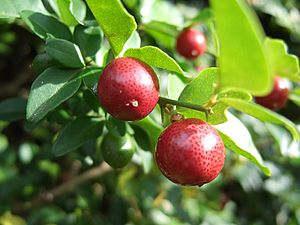Triphasia trifolia facts for kids
Quick facts for kids Triphasia trifolia |
|
|---|---|
 |
|
| Foliage and fruit | |
| Scientific classification |
The limeberry (scientific name: Triphasia trifolia), also known as "sweet lime" or "limoncitong kastila," is a small, spiny plant. It is a close relative of citrus fruits like oranges and lemons. This plant originally comes from tropical parts of southeastern Asia, especially the Indonesian islands and the Philippines.
Contents
About the Limeberry Plant
What Does the Limeberry Look Like?
The limeberry is usually a spiny evergreen shrub, which means it keeps its leaves all year round. It can grow up to 3 meters (about 10 feet) tall. Its leaves are shiny and dark green, and each leaf is made up of three smaller leaflets. Each leaflet is about 2–4 centimeters (about 1–1.5 inches) long.
The plant produces white flowers with three petals. These flowers are about 10–13 millimeters (less than half an inch) long. After the flowers, small, red, round fruits grow. These fruits are 10–15 millimeters (about half an inch) across. They look a bit like tiny citrus fruits. The inside of the fruit is soft and tastes a little like a sweet lime.
Where Does the Limeberry Grow?
People grow limeberry plants for their tasty fruit. Because of this, the plant has been moved to many other warm, tropical places around the world. It has even started growing on its own in some islands in the tropical Pacific Ocean.
However, in some places, like certain islands in the Indian Ocean and along the United States Gulf Coast (from Florida to Texas), the limeberry has become an invasive plant. This means it can spread quickly and sometimes take over areas where other native plants grow.
How People Use Limeberry
The limeberry plant is sometimes grown as a bonsai plant, which is a way of growing small trees in pots. It needs a very warm climate, even warmer than many true citrus plants. So, in many places, it has to be kept in special greenhouses. In truly tropical areas, limeberry might become an important fruit crop in the future.
Some parts of the limeberry plant, especially the leaves, are known to have properties that can help fight germs. In some North Pacific Islands, people have traditionally used limeberry for health purposes. However, scientists need to do more research to fully understand its potential benefits.
Sometimes, in places where it has been introduced, this plant is also seen as a weed because it can grow where it's not wanted.



